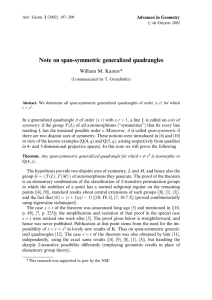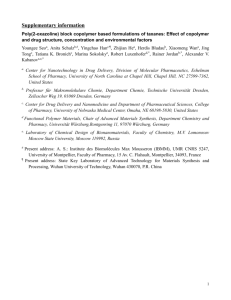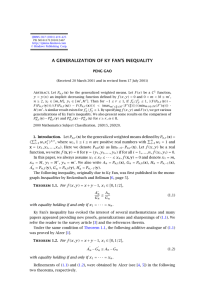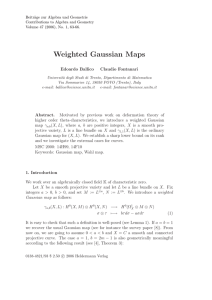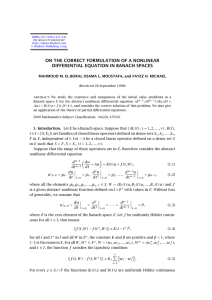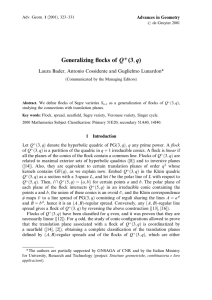On Lorentz–Minkowski geometry in real inner product spaces Walter Benz Advances in Geometry
advertisement
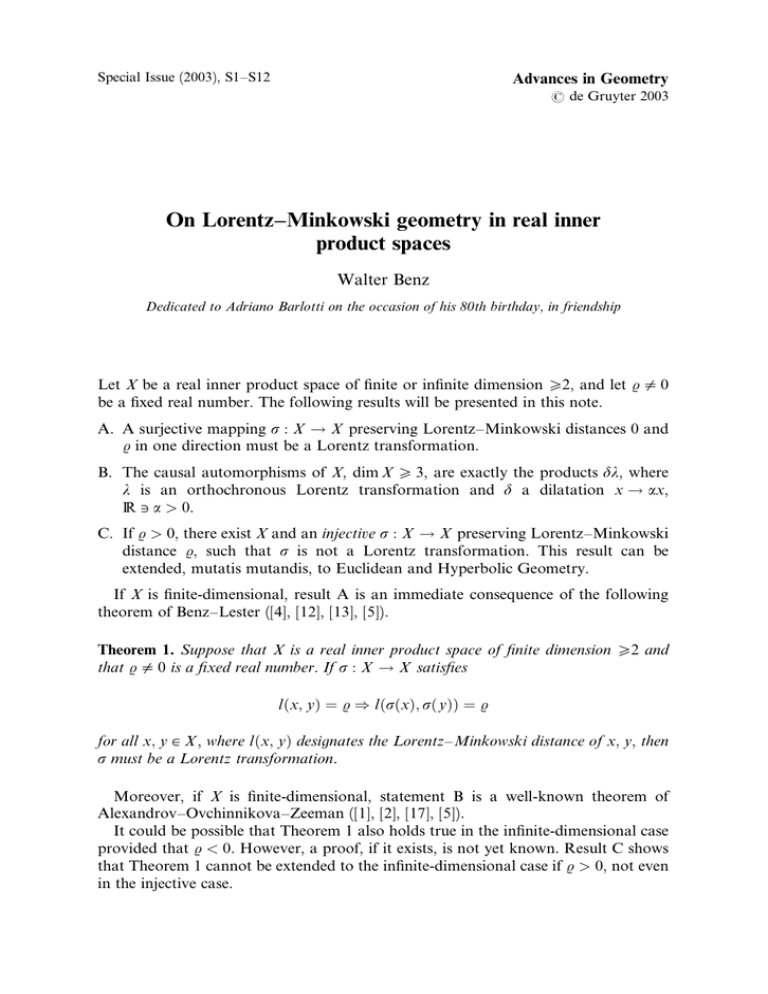
Special Issue (2003), S1–S12 Advances in Geometry ( de Gruyter 2003 On Lorentz–Minkowski geometry in real inner product spaces Walter Benz Dedicated to Adriano Barlotti on the occasion of his 80th birthday, in friendship Let X be a real inner product space of finite or infinite dimension d2, and let % 0 0 be a fixed real number. The following results will be presented in this note. A. A surjective mapping s : X ! X preserving Lorentz–Minkowski distances 0 and % in one direction must be a Lorentz transformation. B. The causal automorphisms of X, dim X d 3, are exactly the products dl, where l is an orthochronous Lorentz transformation and d a dilatation x ! ax, R C a > 0. C. If % > 0, there exist X and an injective s : X ! X preserving Lorentz–Minkowski distance %, such that s is not a Lorentz transformation. This result can be extended, mutatis mutandis, to Euclidean and Hyperbolic Geometry. If X is finite-dimensional, result A is an immediate consequence of the following theorem of Benz–Lester ([4], [12], [13], [5]). Theorem 1. Suppose that X is a real inner product space of finite dimension d2 and that % 0 0 is a fixed real number. If s : X ! X satisfies lðx; yÞ ¼ % ) lðsðxÞ; sðyÞÞ ¼ % for all x; y A X , where lðx; yÞ designates the Lorentz–Minkowski distance of x; y, then s must be a Lorentz transformation. Moreover, if X is finite-dimensional, statement B is a well-known theorem of Alexandrov–Ovchinnikova–Zeeman ([1], [2], [17], [5]). It could be possible that Theorem 1 also holds true in the infinite-dimensional case provided that % < 0. However, a proof, if it exists, is not yet known. Result C shows that Theorem 1 cannot be extended to the infinite-dimensional case if % > 0, not even in the injective case. S2 Walter Benz 1 Notation Let X be a real inner product space of arbitrary finite or infinite dimension d2, i.e. a real vector space equipped with a fixed inner product t : X X ! R; tðx; yÞ ¼: xy; satisfying x 2 :¼ xx > 0 for all x 0 0 of X. Notice that X need not be complete, i.e. that X need not be a real Hilbert space. Take a fixed t A X with t 2 ¼ 1 and define t ? :¼ fx A X j xt ¼ 0g. Observe X ¼ t ? l Rt. We hence get the uniquely determined decomposition x ¼: x þ x0 t with x A t ? and x0 A R for every x A X . Define lðx; yÞ :¼ ðx yÞ 2 ðx0 y0 Þ 2 to be the Lorentz–Minkowski distance of x; y A X . The mapping l : X ! X is called a Lorentz transformation if, and only if, lðx; yÞ ¼ lðlðxÞ; lðyÞÞ holds true for all x; y A X . Remark. It might be noticed that the theory does not seriously depend on the chosen t ([6], p. 229). The Lorentz transformations as defined before can explicitly be written by means of (proper or improper) Lorentz boosts and orthogonal transformations ([6], p. 221): For p A t ? with p 2 < 1 and 1 0 k A R with k 2 ð1 p 2 Þ ¼ 1 define for all x A X , Ap ðxÞ :¼ x0 p þ ðxpÞt; Bp; k ðxÞ :¼ x þ kAp ðxÞ þ k2 A 2 ðxÞ: kþ1 p Obviously, k 2 d 1. The mappings Ap ; Bp; k are linear and Bp; k : X ! X is even bijective. Define also B0; 1 ðxÞ :¼ x x0 t: Bp; k is called a Lorentz boost, a proper one for k d 1, an improper one for k c 1. All Lorentz transformations l of X are exactly given by lðxÞ ¼ ðBp; k oÞðxÞ þ d with a boost Bp; k , an orthogonal and linear mapping o from X into X satisfying oðtÞ ¼ t, and with an element d of X. On Lorentz–Minkowski geometry in real inner product spaces S3 The following theorem was proved by Cacciafesta [9] in the case dim X < y, and by Benz [7] in the general case. Theorem 2. If dim X d 3 and if s : X ! X is bijective and satisfies lðx; yÞ ¼ 0 ) lðsðxÞ; sðyÞÞ ¼ 0 for all x; y A X , then s must be the product of a Lorentz transformation and a dilatation. Important partial results of Theorem 2 were proved by Alexandrov [1] and by Schröder [15], [16]. Schröder even studied the case of an arbitrary field instead of R. 2 Proof of result A Lemma 1. Let g be a real number and x 0 0 be an element of X. Then there exist v 0 0 in X and a in R with v 2 ¼ v02 and ðx þ avÞ 2 ðx0 þ av0 Þ 2 ¼ g: ð1Þ Proof. Case 1: x0 0 0. Take an element e in t ? with e 2 ¼ 1. Then xe 0 x0 or xe 0 x0 . Assume xe 0 ex0 with e A R and e 2 ¼ 1. Now put v :¼ e þ et and, by observing xv 0 x0 v0 , 2aðxv x0 v0 Þ :¼ g þ x02 x 2 : ð2Þ Hence (1) holds true. Casep2: ffiffiffiffiffi x0 ¼ 0. Hence x 0 0 implies x 0 0. Now put v :¼ x þ kxk t with r kzk :¼ z 2 for z A X , and define a by (2). Then also here (1) holds true. Lemma 2. If p 0 q are elements of X and if g A R, there exists r A X satisfying lðr; pÞ ¼ g and lðr; qÞ ¼ 0: ð3Þ Proof. Put x :¼ q p and take elements v and a according to Lemma 1. Hence r :¼ q þ av satisfies (3). r Lemma 3. Suppose that % 0 0 is a fixed real number and that s : X ! X satisfies lðx; yÞ ¼ 0 ) lðsðxÞ; sðyÞÞ ¼ 0 ð4Þ lðx; yÞ ¼ % ) lðsðxÞ; sðyÞÞ ¼ % ð5Þ and for all x; y A X . Then s must be injective. S4 Walter Benz Proof. If p 0 q are elements of X, take, in view of Lemma 2, r A X with lðr; pÞ ¼ % and lðr; qÞ ¼ 0. Hence, by (4), (5), lðr 0 ; p 0 Þ ¼ % and lðr 0 ; q 0 Þ ¼ 0 where we put z 0 ¼ sðzÞ for z A X . Now (6) implies p 0 0 q 0 . ð6Þ r If dim X < y, result A follows from Theorem 1. Suppose now that X is infinitedimensional and that s : X ! X is surjective, satisfying (4) and (5) for all x; y A X , where % 0 0 is a fixed real number. Hence, by Lemma 3, s is injective, and thus bijective. Hence, by Theorem 2, there exists a Lorentz transformation l : X ! X and a real number k 0 0 such that sðxÞ ¼ k lðxÞ for all x A X . Now (5) implies lðx; yÞ ¼ % ) % ¼ lðklðxÞ; klðyÞÞ for all x; y A X , i.e. lðx; yÞ ¼ % implies % ¼ k 2 lðlðxÞ; lð yÞÞ ¼ k 2 lðx; yÞ ¼ k 2 %: Hence k 2 ¼ 1, in view of % 0 0. If k ¼ 1, we get s ¼ l, and if k ¼ 1, we obtain sðxÞ ¼ lðxÞ for all x A X . But this is also a Lorentz transformation. So we have proved Theorem A. Let % 0 0 be a fixed real number and let s : X ! X be a surjective mapping satisfying (4) and (5) for all x; y A X . Then there exist a Lorentz boost Bp; k , a linear, bijective and orthogonal mapping o : X ! X with oðtÞ ¼ t, and an element d of X such that sðxÞ ¼ ðBp; k oÞðxÞ þ d for all x A X . Remark. Theorem A holds true, as was shown, for all real inner product spaces X with dim X d 2. If X ¼ R2 , if we put xy :¼ x1 y1 þ x2 y2 pffiffiffi pffiffiffi for x ¼ ðx1 ; x2 Þ, y ¼ ð y1 ; y2 Þ of X, and t :¼ ð1= 2; 1= 2Þ, then lðx; yÞ ¼ 2ðx1 y1 Þðx2 y2 Þ On Lorentz–Minkowski geometry in real inner product spaces S5 for all x; y A X . Let f be a non-continuous bijection of R, for instance f ð0Þ ¼ 1, f ð1Þ ¼ 0 and f ðxÞ ¼ x otherwise, then sðx1 ; x2 Þ :¼ ð f ðx1 Þ; x2 Þ is a non-continuous bijection of X satisfying lðx; yÞ ¼ 0 , lðsðxÞ; sðyÞÞ ¼ 0 for all x; y A X (Rätz [14]). Hence s cannot be a Lorentz transformation, and it even cannot be a product of a Lorentz transformation and a dilatation. In the case dim X d 2, the mapping sðxÞ ¼ 2x is bijective, it satisfies (4), but not (5) for any given % 0 0. So it cannot be a Lorentz transformation. 3 Causal automorphisms Let x; y be elements of X. Also in the infinite-dimensional case we put xcy if, and only if, lðx; yÞ c 0 and x0 c y0 hold true. A bijection s : X ! X is called a causal automorphism if, and only if, x c y , sðxÞ c sðyÞ for all x; y A X . The proof of Proposition 1 is not di‰cult. Proposition 1. Let x; y; z be elements of X and let k be a real number. Then the following statements hold true. (i) x c x, (ii) x c y and y c x imply x ¼ y, (iii) x c y and y c z imply x c z, (iv) x c y implies x þ z c y þ z, (v) x c y implies kx c ky for k d 0, (vi) x c y implies kx d ky for k < 0. Of course, x < y stands for x c y and x 0 y, x d y for y c x, and x > y for y < x. Suppose that x; y are elements of X satisfying x < y. Then ½x; y :¼ fz A X j x c z c yg is called ordered if, and only if, S6 Walter Benz ucv or vcu holds true for all u; v A ½x; y. Proposition 2. Let x; y be elements of X with x < y. Then lðx; yÞ ¼ 0 if, and only if, ½x; y is ordered. Proof. a) Assume lðx; yÞ ¼ 0 and u A ½x; y, i.e. x 0 c u0 c y0 ; ku xk c u0 x0 ; ky uk c y0 u0 : lðx; yÞ ¼ 0 implies ky xk ¼ y0 x0 . Hence y0 x0 ¼ ky xk c ky uk þ ku xk c y0 x0 ; ð7Þ and thus ky xk ¼ ky uk þ ku xk. Since X is strictly convex, y u, u x must be linearly dependent. Hence there exists a A R with u ¼ x þ aðy xÞ; ð8Þ in view of x 0 y; observe that x ¼ y and ky xk ¼ y0 x0 would imply x ¼ y. Now (7), (8) yield ky xk ¼ ky uk þ ku xk ¼ j1 aj ky xk þ jaj ky xk; i.e. 1 ¼ j1 aj þ jaj, i.e. 0 c a c 1. Hence, with x :¼ y0 x0 , x ¼ ð1 aÞx þ ax ¼ ky uk þ ku xk c ðy0 u0 Þ þ ðu0 x0 Þ ¼ x; i.e. ky uk ¼ y0 u0 , ku xk ¼ u0 x0 , i.e. by (8), u ¼ x þ aðy xÞ: Similarly, v A ½x; y implies v ¼ x þ bðy xÞ; 0 c b c 1: Hence u c v for a c b, and v c u for b c a. b) Assume that ½x; y is ordered and that lðx; yÞ 0 0. Hence, by x < y, we obtain lðx; yÞ < 0 and x0 c y0 , i.e. ðy xÞ 2 < ðy0 x0 Þ 2 and x0 < y0 : Choose e A t ? with e 2 ¼ 1 and e A R with 0 < 2e < ðy0 x0 Þ ky xk; ð9Þ On Lorentz–Minkowski geometry in real inner product spaces S7 and put u :¼ xþy ; 2 v :¼ xþy þ ee: 2 Observe u0 ¼ v0 and v u ¼ ee, i.e. lðu; vÞ ¼ e 2 > 0, i.e. uGv and v G u: ð10Þ Moreover, u; v A ½x; y: ð11Þ In order to prove (11), we observe, first of all, x0 c u0 c y0 and x 0 c v 0 c y0 ; by u0 ¼ v0 ¼ 12 ðx0 þ y0 Þ. Secondly, 1 lðx; uÞ ¼ lðx; yÞ ¼ lðu; yÞ; 4 i.e. lðx; uÞ ¼ lðu; yÞ < 0. The triangle inequality yields y x y x 2 G ee c 2 þ e; i.e. by (9), y x y0 x0 : 2 G ee < 2 Hence yx G ee 2 2 < y x 2 0 0 ; 2 i.e. lðx; vÞ and lðv; yÞ are negative. Because of (10), (11), ½x; y is not ordered, a contradiction. Hence lðx; yÞ ¼ 0. r A Lorentz transformation l of X is called orthochronous if, and only if, it is also a causal automorphism. Proposition 3. The orthochronous Lorentz transformations l are exactly given by all mappings S8 Walter Benz lðxÞ ¼ ðBp; k oÞðxÞ þ d ð12Þ with o : X ! X linear, orthogonal, bijective, oðtÞ ¼ t, d A X , and k d 1. Proof. a) Let l be an arbitrary orthochronous Lorentz transformation, say lðxÞ ¼ ðBp; k oÞðxÞ þ d: Since l is bijective, also o : X ! X must be bijective. Moreover, 0 c t implies lð0Þ c lðtÞ, i.e. d c kt þ kp þ d; i.e. 0 c kp þ kt, i.e. 0 c k, i.e. 1 c k, in view of k 2 d 1. b) Let l be a mapping (12) with proper Bp; k and bijective o satisfying oðtÞ ¼ t. We then have to prove a c b , lðaÞ c lðbÞ for all a; b A X . This is clear for lðxÞ ¼ x þ d, in view of Proposition 1 (iv). It is also clear for lðxÞ ¼ oðxÞ because of 0 d lða; bÞ ¼ lðlðaÞ; lðbÞÞ; oðx þ x0 tÞ ¼ oðxÞ þ x0 t; oðxÞt ¼ oðxÞoðtÞ ¼ xt ¼ 0; i.e. oðxÞ ¼ oðxÞ, and on account of the fact that o1 is linear and orthogonal as well, satisfying o1 ðtÞ ¼ t. Finally, we consider the case lðxÞ ¼ Bp; k ðxÞ with k d 1. Since B1 p; k ¼ Bp; k we only have to prove a c b ) lðaÞ c lðbÞ; i.e. 0 c b a ) 0 c lðbÞ lðaÞ ¼ lðb aÞ, i.e. 0 c x ) 0 c lðxÞ: Again, 0 d lð0; xÞ ¼ lðlð0Þ; lðxÞÞ ¼ lð0; lðxÞÞ. Since z0 ¼ zt for all z A X , we get ½Bp; k ðxÞ0 ¼ x0 ð1 þ kðk 1ÞÞ þ kxp ¼: R: It remains to prove R d 0 in the case 0 c x0 and x 2 x02 ¼ lð0; xÞ c 0. If xp d 0, we get R d 0 since k d 1. If xp < 0, we observe ðxpÞ 2 c x 2 p 2 c x02 1 ¼ x02 ; On Lorentz–Minkowski geometry in real inner product spaces S9 i.e. xp ¼ jxpj c x0 , i.e. x0 c xp, i.e. R d x0 ð1 þ kðk 1ÞÞ kx0 ¼ x0 ðk 1Þ 2 d 0: r Theorem B. The causal automorphisms of X, dim X d 3, are exactly given by all mappings lðxÞ ¼ g ðBp; k oÞðxÞ þ d; ð13Þ where g > 0 is a real number, Bp; k a proper Lorentz boost, o a linear, orthogonal, bijective mapping of X with oðtÞ ¼ t, d an element of X. Proof. Observe that mðxÞ :¼ gx defines a causal automorphism for a real constant g > 0. Hence, by Proposition 3, (13) must be a causal automorphism as well. Suppose now that l : X ! X is an arbitrary causal automorphism. If x 0 y are elements of X with lðx; yÞ ¼ 0, we may assume x0 c y0 without loss of generality, and hence x < y. Thus, by Proposition 2, ½x; y is ordered. Since l is a causal automorphism, also ½lðxÞ; lð yÞ must be ordered and lðxÞ < lð yÞ holds true. Hence, by Proposition 2, lðlðxÞ; lðyÞÞ ¼ 0. Now Theorem 2 implies that lðxÞ ¼ m l1 ðxÞ ð14Þ for all x A X , where l1 is a Lorentz transformation and m 0 0 a real constant. We may assume m > 0 without loss of generality, since otherwise we would consider lðxÞ ¼ ðmÞ ðl1 ðxÞÞ; by observing that also x ! l1 ðxÞ is a Lorentz transformation. Hence x! 1 lðxÞ m is a causal automorphism, and thus, by (14), l1 is an orthochronous Lorentz transformation. In view of Proposition 3, we hence get (13) with the properties described in Theorem B. r 4 Proof of result C Let B be a set with cardðBÞ d @ :¼ cardðRÞ and define X to be the set of all functions x:B!R such that fb A B j xðbÞ 0 0g is finite. We shall write x also in the form x¼ X bAB xðbÞ b: S10 Walter Benz According to this notation, the element b A B is equal to the element x of X with xðbÞ ¼ 1 and xðb 0 Þ ¼ 0 for all b 0 0 b in B. Define x þ y; lx; xy for x; y A X , l A R, by means of x þ y :¼ X ½xðbÞ þ yðbÞb; lx :¼ bAB X ½l xðbÞb bAB P and xy ¼ b A B xðbÞ yðbÞ. Then X is a real inner product space of dimension cardðBÞ with basis B. If fb1 ; . . . ; bn g is a finite subset of B, then there exist exactly @ cardðBÞ ¼ cardðBÞ elements of the form r1 b1 þ þ rn bn with real ri , i ¼ 1; . . . ; n. Since the set of all finite subsets of B has also cardinality cardðBÞ, we get cardðX Þ ¼ cardðBÞ: Take a fixed t A B. Hence t 2 ¼ 1 and cardðX Þ ¼ cardðBnftgÞ: Therefore there exists a bijection m : X ! Bnftg. Suppose that % > 0 is a fixed real number and define sðxÞ :¼ rffiffiffi % mðxÞ: 2 Hence s : X ! X must be injective. Writing again x ¼: x þ x0 t; x A t ? ; x0 A R; for x A X , let x; y be elements of X with % ¼ lðx; yÞ ¼ ðx yÞ 2 ðx0 y0 Þ 2 : In view of x 0 y, the elements b1 :¼ mðxÞ, b2 :¼ mð yÞ are distinct. Observe b1 ; b2 A Bnftg, i.e. b1 ; b2 A t ? . Thus rffiffiffi 2 rffiffiffi % % lðsðxÞ; sðyÞÞ ¼ b1 b2 ¼ %: 2 2 Of course, s cannot be a Lorentz transformation, since lðsðxÞ; sð yÞÞ ¼ % holds true for all distinct elements x; y of X. r Remark. The method followed in this section can be applied to Euclidean and Hyper- On Lorentz–Minkowski geometry in real inner product spaces S11 bolic Geometry in order to find injective mappings s : X ! X which are not distance preserving, but which preserve a fixed distance % > 0. Non-injective mappings leaving invariant a fixed distance %, but not all other distances, were given by Beckman and Quarles [3] in the euclidean case, and by Benz [8] in the hyperbolic case. In this connection observe theorems of Beckman, Quarles [3], Farrahi [10], Kuz’minyh [11], in which, in the finite-dimensional case, distance preserving mappings are characterized by the invariance of one single distance % > 0. Let B be a set with a cardinality d @, and consider the real inner product space X as defined at the beginning of this section. In view of cardðBÞ ¼ cardðX Þ, there exists a bijection m : X ! B: In the euclidean case with the distance notion dðx; yÞ :¼ kx yk for all x; y A X , we define for a fixed % > 0, % sðxÞ :¼ pffiffiffi mðxÞ: 2 qffiffiffiffiffiffiffiffiffiffiffiffiffiffiffiffiffiffiffiffiffiffiffiffiffiffiffiffiffiffi Hence dðsðxÞ; sðyÞÞ ¼ ðsðxÞ sðyÞÞ 2 ¼ % for x 0 y with x; y A X . So every distance 0 0 goes over in distance %. In the hyperbolic case with the distance notion pffiffiffiffiffiffiffiffiffiffiffiffiffipffiffiffiffiffiffiffiffiffiffiffiffiffi hðx; yÞ d 0 and cosh hðx; yÞ :¼ 1 þ x 2 1 þ y 2 xy; we define for a fixed % > 0, sðxÞ :¼ pffiffiffi % 2 sinh mðxÞ: 2 Hence cosh hðsðxÞ; sðyÞÞ ¼ 1 þ 2 sinh 2 %2 ¼ cosh %, i.e. hðsðxÞ; sðyÞÞ ¼ % for every x 0 y with x; y A X . So also here every distance 0 0 goes over in distance %. References [1] A. D. Alexandrov, Seminar report. Uspehi Mat. Nauk. 5 (1950), no. 3 (37), 187. [2] A. D. Alexandrov, V. V. Ovchinnikova, Notes on the foundations of relativity theory. Vestnik Leningrad. Univ. 11, 95 (1953). S12 Walter Benz [3] F. S. Beckman, D. A. Quarles, Jr., On isometries of Euclidean spaces. Proc. Amer. Math. Soc. 4 (1953), 810–815. MR 15,335a Zbl 0052.18204 [4] W. Benz, Eine Beckman–Quarles-Charakterisierung der Lorentztransformationen des Rn . Arch. Math. (Basel ) 34 (1980), 550–559. MR 82h:51022 Zbl 0446.51015 [5] W. Benz, Geometrische Transformationen. Bibliographisches Institut, Mannheim 1992. MR 93i:51002 Zbl 0754.51005 [6] W. Benz, Lorentz–Minkowski distances in Hilbert spaces. Geom. Dedicata 81 (2000), 219–230. MR 2001e:46032 Zbl 0959.51013 [7] W. Benz, Lie sphere geometry in Hilbert spaces. Results Math. 40 (2001), 9–36. MR 2003b:51007 Zbl 0995.51003 [8] W. Benz, Mappings preserving two hyperbolic distances. J. Geom. 70 (2001), 8–16. MR 2002g:51017 Zbl 0988.51015 [9] F. Cacciafesta, An observation about a theorem of A. D. Alexandrov concerning Lorentz transformations. J. Geom. 18 (1982), 5–8. MR 83h:51026 Zbl 0485.51015 [10] B. Farrahi, A characterization of isometries of absolute planes. Resultate Math. 4 (1981), 34–38. MR 82i:51022 Zbl 0472.51009 [11] A. V. Kuz’minyh, Mappings preserving the distance 1. Sibirsk. Mat. Zh. 20 (1979), 597–602. MR 80h:51016 Zbl 0427.51008 [12] J. A. Lester, The Beckman–Quarles theorem in Minkowski space for a spacelike squaredistance. Arch. Math. (Basel ) 37 (1981), 561–568. MR 83e:51008 Zbl 0457.51027 [13] J. A. Lester, Distance preserving transformations. In: Handbook of incidence geometry, 921–944, North-Holland 1995. MR 96j:51019 Zbl 0826.51010 [14] J. Rätz, On light-cone-preserving mappings of the plane. In: General inequalities, 3 (Oberwolfach, 1981), volume 64 of Internat. Schriftenreihe Numer. Math., 349–367, Birkhäuser 1983. MR 86e:51025 Zbl 0527.51006 [15] E. M. Schröder, Zur Kennzeichnung distanztreuer Abbildungen in nichteuklidischen Räumen. J. Geom. 15 (1980), 108–118. MR 82h:51025 Zbl 0463.51015 [16] E. M. Schröder, Ein einfacher Beweis des Satzes von Alexandrov-Lester. J. Geom. 37 (1990), 153–158. MR 91c:51019 Zbl 0704.51010 [17] E. C. Zeeman, Causality implies the Lorentz group. J. Mathematical Phys. 5 (1964), 490–493. MR 28 #5785 Zbl 0133.23205 Received 8 October, 2002 W. Benz, Mathematisches Seminar der Universität, Bundesstr. 55, 20146 Hamburg, Germany Email: benz@math.uni-hamburg.de
